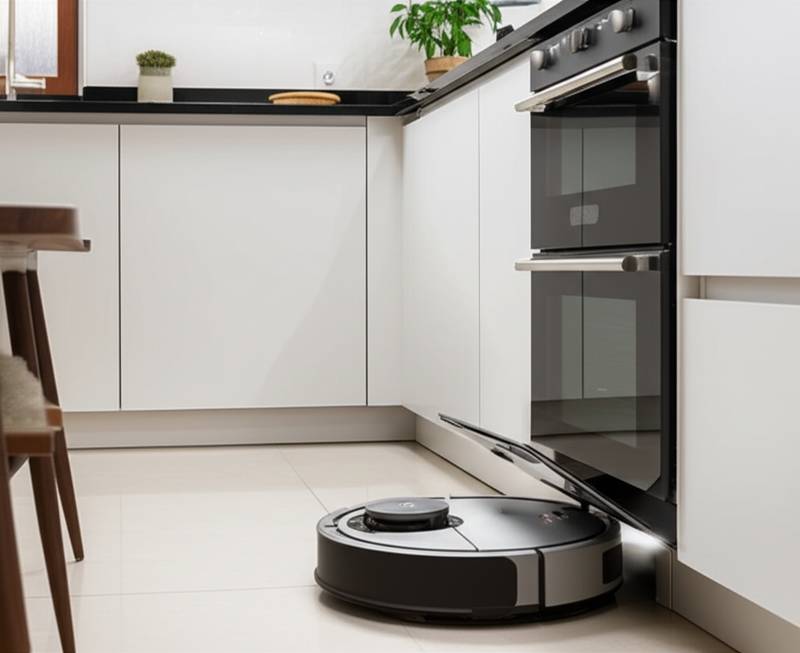Robot Vacuums That Automatically Empty Kitchen Trash
Smart homes advance toward full autonomy. Tasks that once demanded schedules or direct commands now occur without human intervention. The newest development in home cleaning technology proves both innovative and useful. Modern robot vacuums extend beyond floor cleaning to identify, collect, and dispose of kitchen trash on their own. This advancement represents a key step in integrated living, where cleaning integrates smoothly into everyday routines.
From Basic Floor Cleaning to Comprehensive Waste Handling
Robot vacuums began as simple devices for occasional floor maintenance between manual cleanings. They progressed to include room mapping, self-emptying stations, and compatibility with voice controls. The current models advance further by linking with automated waste solutions, managing trash from collection to disposal.
This automation aligns with the rising popularity of interconnected smart home setups. Experts in home automation observe that families increasingly choose tools to eliminate routine tasks. As devices share data, cleaning shifts from a deliberate activity to an unobtrusive service.
The Mechanics Behind the Innovation
Advanced robot vacuums rely on sophisticated sensors and image recognition to detect debris. When connected to a matching smart bin or disposal unit, the vacuum delivers waste to a secure container. Certain systems apply suction to transfer materials from the vacuum's compartment to the bin. Alternative designs feature docking ports that raise and release the internal bin contents.
Communication between the vacuum and waste system occurs via a common home network. The bin signals readiness for a transfer, prompting the vacuum to act. Upon filling, the bin secures the bag and sends a notification to the user's app. This method minimizes direct contact with trash and promotes ongoing kitchen sanitation.
Benefits for Daily Home Life
Kitchens serve as high-traffic areas where food particles, scraps, and wrappers build up quickly. Even regular upkeep fails to prevent overflows or odors from developing. Automated trash handling enhances sanitation and ease, removing an unpopular chore while ensuring order.
Professionals with demanding schedules, parents managing family needs, or individuals averse to waste tasks gain significant relief. The feature also aids those with mobility challenges by eliminating the need to lift heavy bags. Overall, it provides greater comfort and self-reliance.
Pioneering Products and Systems
Leading manufacturers develop these interconnected solutions. Premium robot vacuum lines now offer units that synchronize with versatile disposal hubs, processing dust alongside minor kitchen refuse. Prototypes connect to cabinet-mounted trash compartments that seal and compress loads after robotic delivery.
Consider a setup where the vacuum maps key kitchen zones, like countertops and dining spots. It targets debris buildup in those areas during cycles, then deposits collections into a multifunctional bin. Equipped with scent-neutralizing filters and fill-level detectors, the bin optimizes operations. Such teamwork between cleaners and disposers highlights the adaptability of evolving smart networks.
Seamless Connection to Overall Home Automation
Compatibility drives widespread use. These systems integrate into expansive automation platforms, linking with voice systems, timers, and security interfaces. Users manage disposal alongside lights, alarms, and climate controls from one dashboard.
For instance, after a meal, a voice directive triggers the vacuum to clear the floor, deposit waste in the bin, and prompt sealing. One instruction or preset sequence handles the entire process. This cohesion meets the demand for devices that function as a unified whole.
Contributions to Eco-Friendly Practices
Automated disposal extends to environmental advantages. Sensors track bin capacity and streamline sealing to conserve materials. Devices weigh waste to recommend sorting for recycling. Paired with low-power components and efficient charging, they encourage reduced energy use.
Designers incorporate compostable bags and washable filters to lessen waste. As awareness of sustainability grows, embedding these elements in cleaning tools supports responsible habits.
Addressing Challenges for Wider Use
Excitement surrounds robot vacuums with trash disposal, yet success hinges on cost and dependability. Initial self-emptying units carried high prices and faced occasional breakdowns. Newer versions emphasize robust construction, reduced noise, and simple upkeep.
Though expenses persist as a factor, mainstreaming lowers them over time. People value time savings from convenience, justifying investments in labor-saving tech. Standardized connections across brands build trust, as devices interact reliably. This reliability boosts sustained engagement.
Adapting Routines in Automated Homes
Intelligent appliances reshape daily patterns. With vacuuming and disposal handled automatically, cleaning occurs steadily rather than in bursts. This adjustment liberates schedules and reduces mental load for other pursuits.
Users report greater tranquility from maintained tidiness without oversight. Prompt containment improves air freshness. These tools cultivate calmer, more structured living spaces.
Steps to Integrate This Technology
To adopt this system, evaluate your current smart setup for matches. Select robot vacuums with disposal features and compatible add-ons. Prioritize options that align with leading automation ecosystems for centralized management.
Start by reviewing product specifications for sensor accuracy and network support. Test integration in a single room before full deployment. This approach ensures smooth operation and maximizes benefits.
Embracing Effortless Kitchen Maintenance
Robot vacuums capable of automatic kitchen trash emptying redefine home dynamics. They merge smart engineering with practical utility, converting duties into seamless processes. Future iterations will likely incorporate sorting and organic waste handling. Homes grow more intuitive, greener, and centered on resident well-being.
